Take a walk through the colourful, interconnected rooms and you’ll notice something different. The layout doesn’t look like a traditional classroom. Forget the ‘teacher-up-front-lecturing-to-rows-of-students’ type of arrangement.
“Nothing about edstudiO makes teacher-led models of instruction easy, says founder and director Michelle Hagerman. “The space has really been designed to disrupt this paradigm.”
Play, collaboration and interaction are central to the edstudiO experience, where the focus is on learning through playful engagement with state-of the-art digital tools and physical materials.
“As the places where new teachers and graduate researchers come to think deeply about teaching and learning, Faculties of Education have an important role in supporting meaningful, evidence-informed shifts in the ways we do school,” Hagerman explains.
One of these shifts in educational theory and practice is the turn towards research on learning through play.
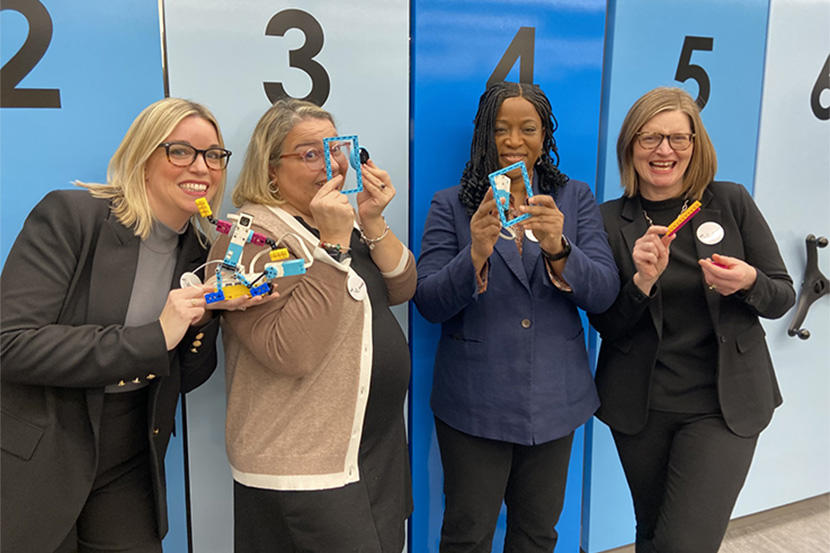
Taking play seriously
Empirical studies showing the benefits of play-based education and its influence on student engagement and well-being are multiplying. Improvements in how students create social connections, solve problems and collaborate in all aspects of learning are just a few of the findings from research on how play positively impacts a range of wellness markers for children and youth.
When a generous grant from the Lego Foundation jumpstarted the creation of the Canadian Playful Schools Network in 2022, eight researchers from the Faculty of Education combined their expertise to coordinate playful learning projects in 41 middle schools across Canada. As one of the CPSN`s strategic priorities, part of this $2.7 million funding was set aside for the construction of the edstudiO.
The vision was to build an innovative learning lab where future teachers and educational researchers could deepen their understanding of learning through play, get hands-on experience, and to advance knowledge in the field of play research. Additional support from the Ontario Ministry of Colleges and Universities and from the Faculty of Education helped the idea for edstudiO become reality. The space was inaugurated in early 2024 and has since become a central hub “where imagination meets transformation in the journey to reshape the future of education.”
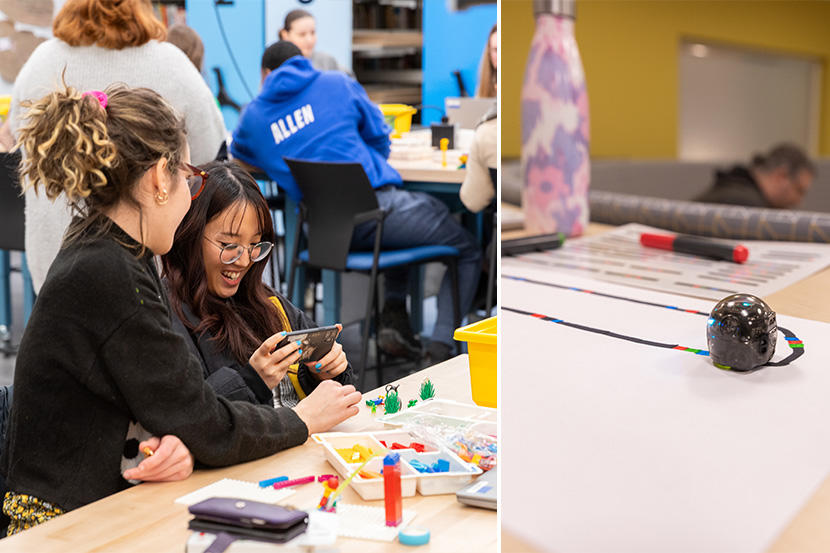
Preparing tomorrow’s teachers
In an interview with CTV News, Hagerman shares her enthusiasm about how BEd candidates (and their students) will benefit from activities in the edstudiO.
“This new space has been designed to give students here in our Faculty — and of course our students are future teachers — access to a flexible, dynamic, innovative space where they can learn how to use a range of digital and analog technologies,” she says, “and then to think really strategically and purposefully about how they would integrate those tools into their own classroom practices.”
“There’s a real emphasis now in schooling on ensuring that students K to 12, understand how to use digital tools for a range of purposes for researching, for creating multi-modal products, for really thinking about how those systems are designed” she adds.
As future educators move through activity zones for virtual reality, digital gaming, circuitry, 3-D printing, and podcast and video production, the experiential lessons of working together enhance their understanding of the power of play. From tapping musical notes on wired donuts to building Lego robotics powered by code from a laptop, edstudiO is a place where playful collaboration creates community.
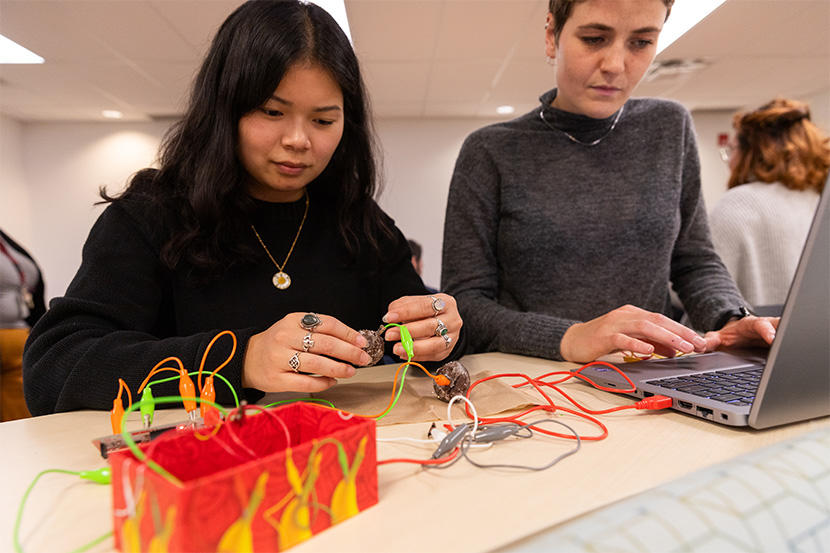
Incorporating Indigenous design
Design choices in the edstudiO are not simply a matter of style.
Guided by recommendations from Faculty advisor from the Kitigan Zibi Anishinabeg community Anita Tenasco (BA ‘93, BEd ‘94), vibrant hues on the walls and furnishings are rich with meaning — as colours that symbolize changing seasons and connection to nature.
Visitors also notice that circles abound in the edstudiO. Informed by Indigenous methods of teaching and learning which favor non-hierarchical interaction, round furniture and moveable, circular seating arrangements are other purposeful design elements. Having the flexibility to sit, stand or move encourages educators and researchers to think about the spatial dimensions of instruction and participation. The space is conceived to foster equitable dialogue and the co-creation of knowledge.
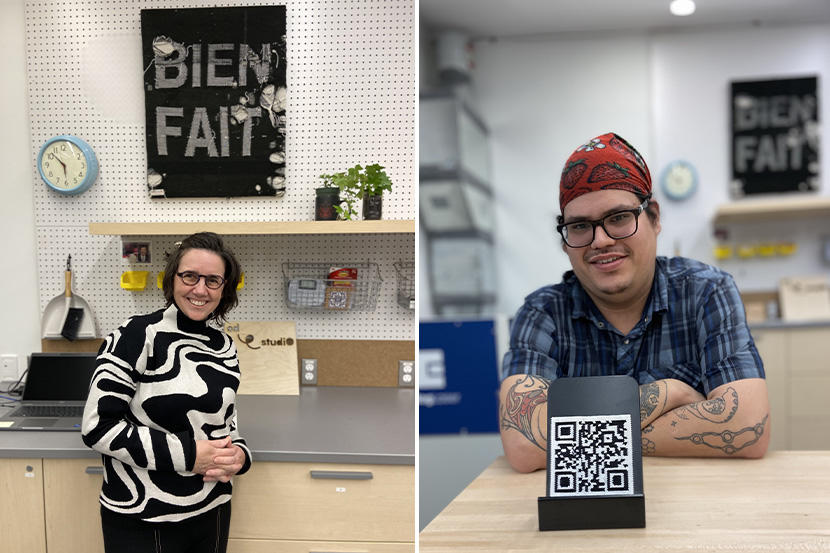
Producing, creating, building
The ethos of edstudiO is deeply rooted in the human capacity to create. It is a place where the boundaries between art and technology, and past and present are intentionally blurred.
Two creators, whose pieces are featured in the space, were special guests during the edstudiO’s official launch. Their oeuvres embody the essence of the edstudiO's call to think deeply about the world we are fashioning today, and for future generations.
Ottawa textile artist Greta Grip’s passion is the “relationship between technology and handmade craft.” Her work entitled “Bien Fait” combines the results of a code-hacked knitting machine with the imperfections of threads gone astray.
For Craig Commanda, a multidisciplinary, Anishinaabe Algonquin artist from Kitigan Zibi, combining the tradition of Indigenous beadwork with digital technology emerged as a physical QR code pointing to his home community.
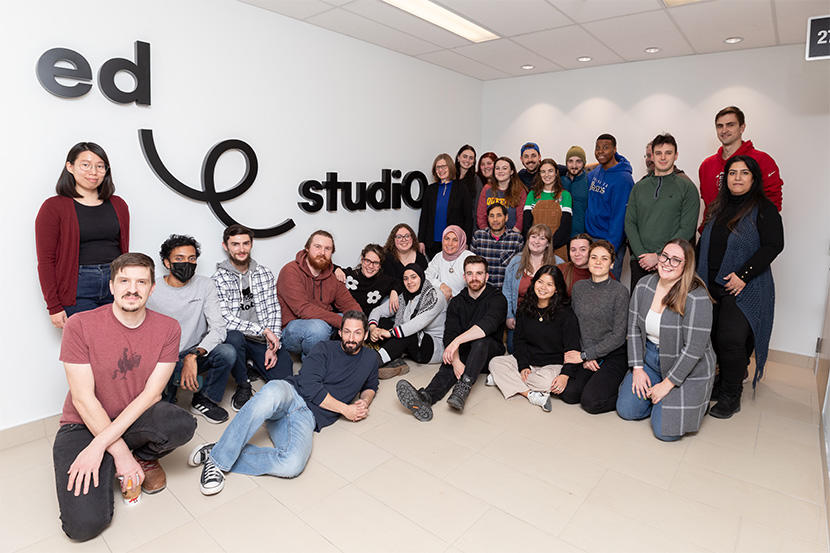
Meaningful and enduring learning
The first cohort of BEd candidates and graduate researchers experienced the inaugural year of the estudiO as a space for discovery and adding practical knowledge about “doing education differently” to their professional teaching repertoires.
For Hagerman, the edstudiO’s opening was an exciting start to a project she has pondered since she was a Teacher Education candidate more than two decades ago.
“It is such a privilege to be able to watch students discover that they can overcome challenges, and think critically about their teaching in ways that haven't been possible in our Faculty before. I am grateful to everyone who has helped make edstudiO a reality" she says.
"I owe a special debt of gratitude to Education Resource Center and Information Technology colleagues Leila Armesto, Dominique Noisette, Fauve Larose-Chevalier, Maura Lynch, and Magali Dando who moved their operations to accommodate the renovations and have championed the development of edstudiO from the start; to University of Ottawa Facilities colleagues Tim Ambery, Jamy Beauchamp, Elena Pizzo, and Kevin Couture, who played critical roles in the design development and management of the construction project; and finally to Tyson Gofton from the Office of the Provost and VP Academic Affairs, who kept us organized and accountable.
"I am so proud of all we have accomplished together -- but we are just getting started. There is so much more to come.”


